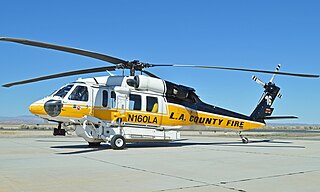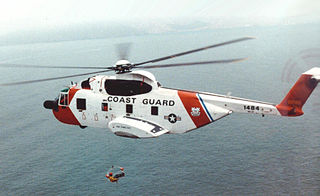
The Boeing Vertol CH-46 Sea Knight is a medium-lift tandem-rotor transport helicopter powered by twin turboshaft engines. It was designed by Vertol and manufactured by Boeing Vertol following Vertol's acquisition by Boeing.

The Boeing CH-47 Chinook is a tandem rotor helicopter developed by American rotorcraft company Vertol and manufactured by Boeing Vertol. The Chinook is a heavy-lift helicopter that is among the heaviest lifting Western helicopters. Its name, Chinook, is from the Native American Chinook people of Oregon and Washington state.

A winch is a mechanical device that is used to pull in or let out or otherwise adjust the tension of a rope or wire rope.

The Bell 212 is a two-blade, medium helicopter that first flew in 1968. Originally manufactured by Bell Helicopter in Fort Worth, Texas, United States, production was moved to Mirabel, Quebec, Canada in 1988, along with all Bell commercial helicopter production after that plant opened in 1986.

The Sikorsky H-19 Chickasaw was a multi-purpose helicopter used by the United States Army and United States Air Force. It was also license-built by Westland Aircraft as the Westland Whirlwind in the United Kingdom. United States Navy and United States Coast Guard models were designated HO4S, while those of the U.S. Marine Corps were designated HRS. In 1962, the U.S. Navy, U.S. Coast Guard and U.S. Marine Corps versions were all redesignated as H-19s like their U.S. Army and U.S. Air Force counterparts.

The Mil Mi-10, given the product number izdeliye 60, is a Soviet military transport helicopter of flying crane configuration, developed from the Mi-6, entering service in 1963.

The Piasecki H-21 Workhorse/Shawnee is an American helicopter, the fourth of a line of tandem rotor helicopters designed and built by Piasecki Helicopter. Commonly called "the flying banana", it was a multi-mission helicopter, utilizing wheels, skis, or floats.

The Bell 47 is a single-rotor single-engine light helicopter manufactured by Bell Helicopter. It was based on the third Bell 30 prototype, which was the company's first helicopter designed by Arthur M. Young. The 47 became the first helicopter certified for civilian use on 8 March 1946. The first civilian delivery was made on 31 December 1946 to Helicopter Air Transport. More than 5,600 Bell 47s were produced, including those under license by Agusta in Italy, Kawasaki Heavy Industries in Japan, and Westland Aircraft in the United Kingdom. The Bell 47J Ranger is a modified version with a fully enclosed cabin and tail boom.

The Sikorsky S-70 is an American medium transport/utility helicopter family manufactured by Sikorsky Aircraft. It was developed for the United States Army in the 1970s, winning a competition to be designated the UH-60 Black Hawk and spawning a large family in U.S. military service. New and improved versions of the UH-60 have been developed since. Civilian versions, and some military versions are produced under various S-70 model designations.

The Sikorsky HH-52 Seaguard was a single turbine engine, three-blade rotor amphibious helicopter. Originally developed as a commercial venture by the Sikorsky Aircraft Corporation of Stratford, Connecticut, it was used by the United States Coast Guard primarily for air-sea rescue. The HH-52 has been replaced by non-amphibious types such as the HH-65 Dolphin, which rely solely on the use of a winch from a low hover to conduct rescue operations.

The Sikorsky S-64 Skycrane is an American twin-engine heavy-lift helicopter. It is the civil version of the United States Army's CH-54 Tarhe. It is currently produced as the S-64 Aircrane by Erickson Inc.

A military transport aircraft, military cargo aircraft or airlifter is a military-owned transport aircraft used to support military operations by airlifting troops and military equipment. Transport aircraft are crucial to maintaining supply lines to forward bases that are difficult to reach by ground or waterborne access, and can be used for both strategic and tactical missions. They are also often used for civilian emergency relief missions by transporting humanitarian aid.

The Bell 214 is a medium-lift helicopter derived from Bell Helicopter's ubiquitous UH-1 Huey series. The Bell 214ST shares the same model number, but is a larger, much-modified twin-engine derivative.

The EurocopterEC130 is a single engine light utility helicopter developed from the earlier Eurocopter AS350 Écureuil, one of the primary changes from which was the adoption of a Fenestron anti-torque device in place of a conventional tail rotor. It was launched and produced by the Eurocopter Group, which would later be rebranded as Airbus Helicopters.

The Schweizer 330 and S333 are turbine-powered developments of the Schweizer 300 light piston-powered helicopter. As of 2007, only the Schweizer 333 remains in production. In February 2009, the 333 was rebranded as the Sikorsky S-333. In 2018 the Schweizer R.S.G. bought the Schweizer Aircraft from Sikorsky Aircraft and it was rebranded as Schweizer S333 again.

The Kaman K-MAX is an American helicopter with intermeshing rotors (synchropter) by Kaman Aircraft. It is optimized for external cargo load operations, and is able to lift a payload of over 6,000 pounds (2,700 kg), which is more than the helicopter's empty weight. An unmanned aerial vehicle version with optional remote control has been developed and evaluated in extended practical service in the war in Afghanistan.

An aerial crane or flying crane is a helicopter used to lift heavy or awkward loads. As aerial cranes, helicopters carry loads connected to long cables or slings in order to place heavy equipment when other methods are not available or economically feasible, or when the job must be accomplished in remote or inaccessible areas, such as the tops of tall buildings or the top of a hill or mountain, far from the nearest road. Helicopters were first used as aerial cranes in the 1950s, but it was not until the 1960s that their popularity in construction and other industries began to catch on. The most consistent use of helicopters as aerial cranes is in the logging industry to lift large trees out of rugged terrain where vehicles are not able to reach, or where environmental concerns prohibit roadbuilding. These operations are referred to as longline because of the long, single sling line used to carry the load.

The Sikorsky S-61R is a twin-engine helicopter used in transport or search and rescue roles. A developed version of the S-61/SH-3 Sea King, the S-61R was also built under license by Agusta as the AS-61R. The S-61R served in the United States Air Force as the CH-3C/E Sea King and the HH-3E Jolly Green Giant, and with the United States Coast Guard as the HH-3F "Pelican".

The Sikorsky S-60 helicopter, a prototype "flying crane", was derived from the S-56 in 1958. Proving to be underpowered, the development of the S-60 led to the larger, turbine-engined Sikorsky CH-54 Tarhe military transport helicopter, and its civil S-64 Skycrane variant, which were already on the drawing board by the time the sole example of the S-60 crashed on 3 April 1961.

The Robinson R66 is a helicopter designed and built by Robinson Helicopter Company. It has five seats, a separate cargo compartment and is powered by a Rolls-Royce RR300 turboshaft engine. The R66 is slightly faster and smoother than the Robinson R44 from which it is derived. The R66 received both type and production certificates from the U.S. Federal Aviation Administration (FAA) on October 25, 2010.






















